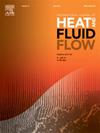强制风冷条件下空气温度对换热系数的影响
IF 2.6
3区 工程技术
Q2 ENGINEERING, MECHANICAL
International Journal of Heat and Fluid Flow
Pub Date : 2025-01-06
DOI:10.1016/j.ijheatfluidflow.2024.109741
引用次数: 0
摘要
采用离线实验和数值模拟相结合的方法,研究了不同空气温度下钢棒的温度分布,以阐明钢棒的冷却机制。在风速为22 m/s时,空气温度的升高显著降低了对流换热系数。连续的气流在杆的顶部形成了低雷诺数的区域,在杆的两侧形成了高雷诺数的区域,显著提高了顶部的侧对流换热系数。根据实验和模拟结果,推导出不同杆位换热系数的经验公式,并通过实验验证,计算误差小于4%。本文章由计算机程序翻译,如有差异,请以英文原文为准。
The influence of air temperature on heat transfer coefficient under forced air-cooling conditions
Employing a combined approach of offline experiments and numerical simulations, this study investigates the temperature distribution of steel rods under various air temperatures during forced air-cooling to elucidate the cooling mechanisms of steel rods. At a wind speed of 22 m/s, an increase in air temperature significantly reduces the convective heat transfer coefficient. Continuous airflow creates regions of low Reynolds numbers at the top of the rod and high Reynolds numbers along its sides, significantly enhancing the side convective heat transfer coefficient over the top. Empirical formulas for heat transfer coefficients at different rod positions were derived from experimental and simulation results and validated experimentally with a calculation error of less than 4 %.
求助全文
通过发布文献求助,成功后即可免费获取论文全文。
去求助
来源期刊

International Journal of Heat and Fluid Flow
工程技术-工程:机械
CiteScore
5.00
自引率
7.70%
发文量
131
审稿时长
33 days
期刊介绍:
The International Journal of Heat and Fluid Flow welcomes high-quality original contributions on experimental, computational, and physical aspects of convective heat transfer and fluid dynamics relevant to engineering or the environment, including multiphase and microscale flows.
Papers reporting the application of these disciplines to design and development, with emphasis on new technological fields, are also welcomed. Some of these new fields include microscale electronic and mechanical systems; medical and biological systems; and thermal and flow control in both the internal and external environment.
 求助内容:
求助内容: 应助结果提醒方式:
应助结果提醒方式:


